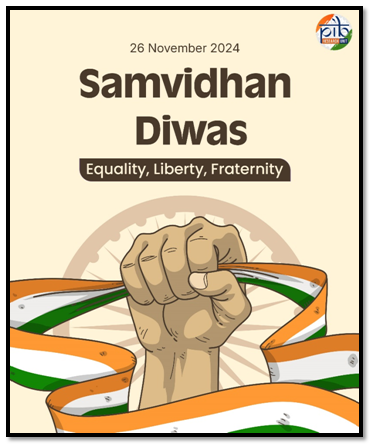Ministry of Information & Broadcasting
Samvidhan Diwas 2024
Celebrating the spirit of Unity and Democracy
Posted On: 25 NOV 2024 12:22PM
The adoption of the Indian Constitution on November 26, 1949, marked a defining moment in the nation’s history, signalling the dawn of self-governance and democracy. For nearly three years, some of the greatest minds in the nation gathered in the Constituent Assembly Hall in Delhi, engaging in tireless debates, drafting, and refining the foundation of newly independent India. This document would not only define the structure of governance but also embody the hopes, dreams, and aspirations of millions of Indians, uniting them under the banner of justice, liberty, equality, and fraternity. As the backbone of the world's largest democracy, it continues to guide the nation’s progress, adapting to its evolving social, political, and economic landscape while preserving the core ideals that unite its people.

The Constitution is a celebration of Swaraj: the joy of self-governance. It marked India’s transition from a colonial subject to a sovereign democracy, affirming the power of its people to shape their destiny. By institutionalizing democratic practices, it empowered citizens to participate in governance, uphold their rights, and demand accountability from their leaders.
The celebration of Samvidhan Diwas, or Constitution Day, on November 26, reminds us of this enduring legacy. Instituted in 2015, this day offers an opportunity for reflection. It calls upon every citizen to understand their rights and fulfill their duties as outlined in the Constitution. Across the country, schools, colleges, and institutions commemorate the day with readings of the Preamble, discussions, and activities that emphasize the timeless values enshrined in the document.
In a land of unparalleled diversity spanning languages, ethnicities, religions, and cultures, the Indian Constitution stands as a unifying force! Inspired by a blend of global and indigenous ideas, the Constitution seamlessly integrates elements from the British parliamentary system, the American Bill of Rights, and French ideals of liberty, equality, and fraternity, while remaining deeply rooted in India’s traditions and realities. Its comprehensive yet flexible structure ensures that it is both aspirational and pragmatic, capable of addressing contemporary challenges while upholding timeless values.
Designed to embrace pluralism, the Constitution of India ensures that every community and individual finds a voice and place within the framework of the nation. Through its inclusive provisions and progressive vision, the Constitution transforms India's diversity into its strength, creating a cohesive national identity grounded in acceptance, mutual respect, and shared purpose. The Constitution enshrines this inclusivity, guaranteeing fundamental rights like freedom of religion, language, and cultural practices, ensuring that diversity strengthens, rather than divides, the nation.
Drafting a Constitution capable of accommodating such vast socio-economic and cultural diversity was no small feat. The Constituent Assembly, which initially comprised 389 members (later reduced to 299 post-Partition), was a microcosm of Indian society. Its members hailed from varied backgrounds, including government provinces, princely states, and chief commissioner provinces. The Assembly itself reflected India’s vibrancy, consisting of freedom fighters, legal luminaries, social reformers, and visionaries. Together, they shouldered the responsibility of creating a document that could unite a nation as diverse as India. They brought their lived experiences of colonial rule, partition, and independence to the table, ensuring that the Constitution was a document resonating with the aspirations of every Indian. Among them were fifteen extraordinary women, who championed equal rights and universal suffrage at a time when women’s participation in governance was a rarity even in developed nations. Their advocacy and perspectives were instrumental in shaping a Constitution that is both inclusive and forward-looking.
The Indian Constitution stands as a "living document," a testament to its adaptability and enduring relevance in a rapidly changing world. Far from being a static legal framework, it embodies the spirit of a dynamic and diverse nation, weaving together governance, individual empowerment, and social transformation. Its provisions for fundamental rights, directive principles of state policy, and governance structures ensure both: empowerment of citizens and accountability of the state.It has consistently upheld the rule of law, acting as a stabilizing force during periods of political turbulence and social upheaval. In moments of crisis, whether due to internal discord or external challenges, the Constitution has reaffirmed its role as a beacon of hope and a guiding light for the nation.
One of the Constitution’s most remarkable features is its adaptability. With 105 amendments to date, it has evolved to address the shifting needs of society, technology, and global developments, all while preserving its foundational principles. This adaptability underscores its foresight, allowing it to remain a relevant and effective governance tool without compromising its core ideals. Despite scepticism in its early days, with critics questioning how long a diverse and newly independent country could sustain itself, the Constitution has stood the test of time, providing stability and unity for over seven decades.
For a nation as diverse as India, the Constitution is a promise. It binds together a mosaic of cultures, languages, and traditions into a cohesive fabric. Preserved in helium-filled cases in the Parliament Library, the original copies of the Constitution continue to inspire awe, reminding us of the vision of those who dreamed of an India built on the principles of equality and justice. It empowers citizens, and in turn, citizens empower the Constitution—by adhering to it, protecting it, and upholding its ideals in their daily lives.
As we observe Samvidhan Diwas, we honor the extraordinary moment in 1949 when this monumental document was adopted. It is a day to celebrate the past, engage with the present, and commit ourselves to a future where the ideals of the Constitution remain the cornerstone of our democracy. It is a reminder that the Constitution is not just the preserve of the government or the judiciary—it is a collective responsibility, a shared legacy, and a promise that binds us all.
References
file:///C:/Users/DELL/Downloads/Constitution%20day.pdf
https://pib.gov.in/newsite/printrelease.aspx?relid=131806
https://mpa.gov.in/sites/default/files/pdf
https://www.mygov.in/campaigns/constitution-day/
https://delhicourts.nic.in/public/Circulars/2019/12/19a.pdf
https://necouncil.gov.in/sites/default/files/Write-Up%20For%20Website.pdf
Download in PDF
***
Santosh Kumar/Ritu Kataria/ Madiha Iqbal
(Features ID: 153449)
Visitor Counter : 262